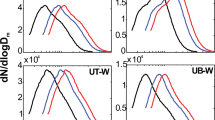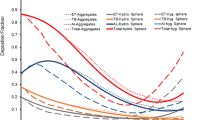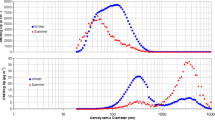Abstract
Aerosol pollution in urban environments has been recognized to be responsible for important pathologies of the cardiovascular and respiratory systems. In this perspective, great attention has been addressed to Ultra Fine Particles (UFPs < 100 nm), because they efficiently penetrate into the respiratory system and are capable of translocating from the airways into the blood circulation. This paper describes the aerosol regional doses deposited in the human respiratory system in a high-traffic urban area. The aerosol measurements were carried out on a curbside in downtown Rome, on a street characterized by a high density of autovehicular traffic. Aerosol number-size distributions were measured by means of a Fast Mobility Particle Sizer in the range from 5.6 to 560 nm with a 1 s time resolution. Dosimetry estimates were performed with the Multiple-Path Particle Dosimetry model by means of the stochastic lung model. The exposure scenario close to traffic is represented by a sequence of short-term peak exposures: about 6.6 × 1010 particles are deposited hourly into the respiratory system. After 1 h of exposure in proximity of traffic, 1.29 × 1010, 1.88 × 1010, and 3.45 × 1010 particles are deposited in the head, tracheobronchial, and alveolar regions. More than 95 % of such doses are represented by UFPs. Finally, according to the greater dose estimated, the right lung lobes are expected to be more susceptible to respiratory pathologies than the left lobes.







Similar content being viewed by others
References
Anjilvel S, Asgharian BA (1995) Multiple-path model of particle deposition in the rat lung. Fundam Appl Toxicol 28:41–50
Applied Research Associates (ARA) 2009 Multiple-Path Particle Dosimetry Model (MPPD v 2.11). http://www.ara.com
Asgharian B, Hofmann W, Bergmann R (2001) Particle deposition in a multiple-path model of the human lung. Aerosol Sci Technol 34:332–339
Avino P, Manigrasso M (2008) Ten-year measurements of gaseous pollutants in urban air by an open-path analyzer. Atmos Environ 42:4138–4148
Avino P, Brocco D, Cecinato A, Lepore L, Balducci C (2002) Carbonaceous components in atmospheric aerosol: measurement procedures and characterization. Ann Chim 92:333–341
Avino P, De Lisio V, Grassi M, Lucchetta MC, Messina B, Monaco G, Petraccia L, Quartieri G, Rosentzwig R, Russo MV, Spada S, Valenzi VI (2004) Influence of air pollution on chronic obstructive respiratory diseases: comparison between city (Rome) and hillcountry environments and climates. Ann Chim 94:629–636
Avino P, Casciardi S, Fanizza C, Manigrasso M (2011) Deep investigation of ultrafine particles in urban air. Aerosol Air Qual Res 11:654–663
Avino P, Manigrasso M, Fanizza C, Carrai P, Solfanelli L (2013a) Submicron particles in smoke resulting from welding alloys and cast alloy in metalworking industry. Med Lav 104:335–350
Avino P, Lopez F, Manigrasso M (2013b) Regional deposition in human respiratory system of submicrometer aerosol determined at 1 Hz frequency. Aerosol Air Qual Res 13:1702–1711
Avino P, Manigrasso M, Rosada A, Dodaro A (2015a) Measurement of organic and elemental carbon in downtown Rome and background area: physical behavior and chemical speciation. Environ Sci Process Impacts 17:300–315
Avino P, Manigrasso M, Pandolfi P, Tornese C, Settimi D, Paolucci N (2015b) Submicron particles during macro-and micro-weldings procedures in industrial indoor environments and health implications for welding operators. Metals 5:1045–1060
Brook RD, Brook JR, Urch B, Vincent R, Rajagopalan S, Silverman F (2002) Inhalation of fine particulate air pollution and ozone causes acute arterial vasoconstriction in healthy adults. Circulation 105:1534–1536
Delfino RJ, Zeiger RS, Seltzer JM, Street DH (1998) Symptoms in pediatric asthmatics and air pollution: differences in effects by symptom severity, anti-inflammatory medication use and particulate averaging time. Environ Health Perspect 106:751–761
Directive 2008/50/EC of the European Parliament and of the Council of 21 May 2008 on ambient air quality and cleaner air for Europe. Official Journal of the European Union. L 152 11 June 2008.
Dominici F, Peng RD, Bell ML, Pham L, McDermott A, Zeger SL, Samet JM (2006) Fine particulate air pollution and hospital admission for cardiovascular and respiratory diseases. JAMA, J Am Med Assoc 295:1127–1134
Donaldson K, Stone V, Seaton A, MacNee W (2001) Ambient particle inhalation and the cardiovascular system: potential mechanisms. Environ Health Perspect 109:523–527
Fanizza C, Casciardi S, Avino P, Manigrasso M (2010) Measurements and characterization by transmission electron microscopy of ultrafine particles in the urban air of Rome. Fresenius Environ Bull 19:2026–2032
IARC (2015) Monographs on the evaluation of carcinogenic risks to humans: outdoor air pollution. International Agency for Research on Cancer, Lyon
ICRP (1994) Human respiratory tract model for radiological protection. A report of a task group of the International Commission on Radiological Protection. Ann ICRP 24:1–482
Jeong C-H, Greg J, Evans GJ (2009) Inter-comparison of a fast mobility particle sizer and a scanning mobility particle sizer incorporating an ultrafine water-based condensation particle counter. Aerosol Sci Technol 43:364–373
Koblinger L, Hofmann W (1985) Analysis of human lung morphometric data for stochastic aerosol deposition calculations. Phys Med Biol 30:541–556
Koblinger L, Hofmann W (1990) Monte Carlo modeling of aerosol deposition in human lungs. Part I: simulation of particle transport in stochastic lung structure. J Aerosol Sci 21:661–674
Manigrasso M, Avino P (2012) Fast evolution of urban ultrafine particles: implications for deposition doses in the human respiratory system. Atmos Environ 51:116–123
Manigrasso M, Avino P, Fanizza C (2009) Ultrafine particles in the urban area of Rome. Fresenius Environ Bull 18:1341–1347
Manigrasso M, Stabile L, Avino P, Buonanno G (2013) Influence of measurement frequency on the evaluation of short-term dose of sub-micrometric particles during indoor and outdoor generation events. Atmos Environ 67:130–142
Manigrasso M, Buonanno G, Fuoco FC, Stabile L, Avino P (2015a) Aerosol deposition doses in the human respiratory tree of electronic cigarette smokers. Environ Pollut 196:257–267
Manigrasso M, Buonanno G, Stabile L, Morawska L, Avino P (2015b) Particle doses in the pulmonary lobes of electronic and conventional cigarette users. Environ Pollut 202:24–31
Marini S, Buonanno G, Stabile L, Avino P (2015) A benchmark for numerical scheme validation of airborne particle exposure in street canyons. Environ Sci Pollut Res 22:2051–2063
NEPC (1998) National environment protection measure and impact statement for ambient air quality. National Environment Protection Council, Adelaide
NEPC (2003) Variation to the national environment protection (ambient air quality) measure. National Environment Protection Council, Adelaide
Oberdörster G, Sharp Z, Atudorei V, Elder A, Gelein R, Kreyling W, Cox C (2004) Translocation of inhaled ultrafine particles to the brain. Inhal Toxicol 16:437–445
Oberdörster G, Oberdörster E, Oberdörster J (2005) Nanotoxicology: an emerging discipline evolving from studies of ultrafine particles. Environ Health Perspect 113:823–840
Parkash O (1977) Lung cancer. A statistical study based on autopsy data from 1928 to 1972. Respiration 34:295–304
Peters A, Veronesi B, Calderón-Garcidueñas L, Gehr P, Chen LC, Geiser M, Reed W, Rothenrutishauser B, Schürch S, Schulz H (2006) Translocation and potential neurological effects of fine and ultrafine particles a critical update. Part Fibre Toxicol 3:13. doi:10.1186/1743-8977-3-13
Price OT, Asgharian B, Miller FJ, Cassee FR, de Winter-Sorkina R (2002) Multiple Path Particle Dosimetry Model (MPPD v. 1.0): a model for human and rat airway particle dosimetry, v 1.0. National Institute for Public Health and the Environment (RIVM), Bilthoven, The Netherlands. http://www.ara.com/products/mppd.htm. Accessed 21 July 2015.
Simkhovich BZ, Kleinman MT, Kloner RA (2008) Air pollution and cardiovascular injury epidemiology, toxicology, and mechanisms. J Am Coll Cardiol 52:719–726
Terzano C, Di Stefano F, Conti V, Graziani E, Petroianni A (2010) Air pollution ultrafine particles: toxicity beyond the lung. Eur Rev Med Pharmacol Sci 14:809–821
TSI (2009) www.tsi.com/uploadedFiles/Product_Information/Literature/Catalogs/Particle_Catalog_ Web.pdf. Accessed 21 July 2015.
USEPA (2006) U.S. Environmental Protection Agency 40 CFR Part 50, 2006. In: National Ambient Air Quality Standards for Particulate Matter, Part II. Final Rule
Von Klot S, Wölke G, Tuch T, Heinrich J, Dockery DW, Schwartz J, Kreylingz WG, Wichmann HE, Peters A (2002) Increased asthma medication use in association with ambient fine and ultrafine particles. Eur Respir J 20:691–702
Winkler-Heil R, Hofmann W (2009) Inter- and intra-lobar deposition of inhaled particles. Proc. Eur Aerosol Conf 2009, Karlsruhe, Abstract T101A01.
Acknowledgments
The authors wish to thank ARA for MPPD version 2.1.
This study was supported by INAIL grants P19L08, P20L01 and P20L09.
Author information
Authors and Affiliations
Corresponding author
Additional information
Responsible editor: Philippe Garrigues
Rights and permissions
About this article
Cite this article
Manigrasso, M., Vernale, C. & Avino, P. Traffic aerosol lobar doses deposited in the human respiratory system. Environ Sci Pollut Res 24, 13866–13873 (2017). https://doi.org/10.1007/s11356-015-5666-1
Received:
Accepted:
Published:
Issue Date:
DOI: https://doi.org/10.1007/s11356-015-5666-1




